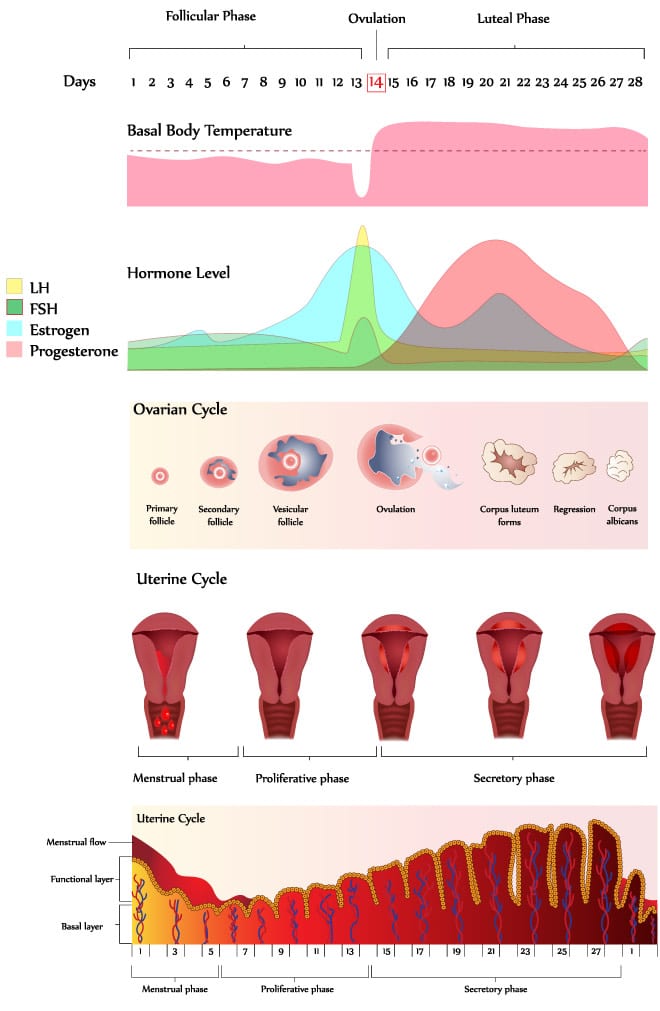The menstrual cycle can be divided into two main cycles, ovarian and uterine, each having three phases.

Ovarian cycle
The ovarian cycle consists of the follicular phase, ovulation and the luteal phase.
Follicular phase
During the follicular phase, the ovarian follicles mature and prepare to release an egg. Through the influence of a rise in FSH, a number of follicles are stimulated during the first few days of the cycle. Under the influence of hormones, only one (sometimes more) dominant follicle will mature and this will contain the egg. This occurs between day one and day 12 of the average 28-day cycle.
Ovulation
This is the second phase of the cycle, in which a mature egg is released from the follicle. Under the influence of rising estrogen levels produced by the maturing follicle, a rapid surge of LH is released by the anterior pituitary gland, which triggers ovulation and causes the dominant mature follicle to release an egg. This occurs between days 12 and 15 of the average 28-day cycle.
After being released from the ovary, the egg is swept up into the far end of the fallopian tube. If sperm are present in the fallopian tube, the egg may be fertilised and begin the process of embryo development. The developing embryo may take three to five days to reach the uterus and implant into the endometrium, which may result in a pregnancy. If the egg is not fertilised within 12-24 hours of ovulation, it will dissolve and be absorbed in the fallopian tube.
Some individuals may experience pain in the lower abdomen at ovulation. The basal body temperature may rise slightly at ovulation. Urine test kits are available to detect the LH surge, which occurs 24-36 hours before ovulation.
Luteal phase
The luteal phase also corresponds with the secretory phase of the uterine cycle. The follicle in the ovary that produced the egg becomes the corpus luteum, which produces the hormones progesterone and estrogen to provide nutrition to the endometrium (lining). If the embryo implants into the endometrium, it starts to produce human chorionic gonadotropin (hCG) – the hormone tested for pregnancy. The hCG causes the ovary to continue producing progesterone to support the pregnancy. If there is no fertilisation and implantation, the ovary stops producing progesterone, causing the uterine lining to shed, and a period starts.
Uterine cycle
The uterine cycle consists of menstruation and the proliferative and secretory phases.
Menstruation
Menstruation, or the period, is the start of the uterine cycle. This flow is usually a sign that pregnancy has not been achieved. Common symptoms such as cramping, breast tenderness, nausea and irritability may occur before and during a period. These symptoms are commonly known as PMS or premenstrual syndrome.
Proliferative phase
The proliferative phase is the second stage of the cycle, when hormones cause the endometrial lining in the uterus to grow or proliferate. As the ovarian follicles start to mature, oestradiol is released, causing the formation of a new layer of the endometrium.
Secretory phase
The secretory phase, the final one of the uterine cycle, corresponds with the luteal phase of the ovarian cycle. During the secretory phase, the follicle that released the egg (corpus luteum) produces the hormone progesterone, which allows the endometrium to be receptive to implantation of the developing embryo and support early pregnancy.
Mood and behaviour might be affected during the menstrual cycle: mild to severe mood swings may occur. The change in hormone levels may contribute to increased feelings of empathy.




